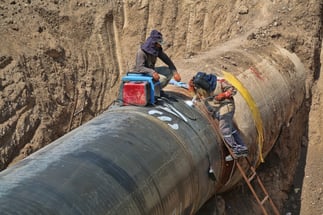The Impact of Corrosion on Pipelines
Pipelines are the major arteries of the energy sector, transporting oil, gas and other crucial products that fuel the American economy. Keeping these arteries healthy and free of defects is critical as a failed pipeline can lead to significant property damage, injury, and death.
Corrosion is one of the leading causes of pipeline incidents with the U.S. Pipeline and Hazardous Materials Safety Administration (PHMSA) data showing 18 percent of pipeline incidents on average were caused by corrosion between 1998 and 2017.
“Corrosion is considered a time-dependent threat which means it grows or worsens with time if left unmitigated. As a result, early detection and mitigation are necessary to minimize the impact of corrosion,” says PHMSA.
Some estimate that corrosion costs the oil and gas industry more than $1 billion annually.
What Causes Pipeline Corrosion?
Corrosionpedia, the online hub for corrosion industry professionals, says that pipeline corrosion is a natural deterioration and destruction of pipe material and essential properties due to electrochemical and other ingredient reactions of pipeline materials with their environment.
Pipeline corrosion can occur on the inside as well as the outside surfaces and occurs naturally due to the gradual and continuous environmental attack on pipe materials.
“This reaction causes the iron in the steel pipe or other pipeline appurtenances to oxidize (rust),” says PHMSA. Both metal and non-metal pipes, pipe joints, welds, and surface coatings can be affected by corrosion.
“Corrosion changes the structure, essential properties and chemical composition of materials,” says Corrosionpedia.
Environmental conditions that can cause corrosion, according to Corrosionpedia, include:
- Soil chemistry

- Ambient humidity
- Proximity to salt water
- Turbulence
- Belocity
- Pressure
- Type of transported liquid or gas
- Stray current proximity
Characterizing Corrosion by Where and How it Occurs
PHMSA breaks down pipeline corrosion by where and/or how it occurs:
- External Corrosion: Occurs due to environmental conditions on the exterior surface of the steel pipe that can cause an electrochemical interaction between the exterior of the pipeline and the soil, air, or water surrounding it. Galvanic and atmospheric corrosion are common types of external corrosion.
- Internal Corrosion: Occurs due to a chemical attack on the interior surface of a steel pipe from the products transported in the pipe. This can be from either the commodity transported, or from other materials carried along with the commodity, such as water, hydrogen sulfide, and carbon dioxide.
- Other Types of Corrosion: Can occur due to specific material defects or environments. These include stress corrosion cracking (SCC), microbiologically influenced corrosion (MIC), stray current interference corrosion, and selective seam corrosion. These types of corrosion problems can be exacerbated by environmental conditions, manufacturing processes, pipe wall erosion from the transported commodity, physical location with respect to other structures, and applied stresses resulting from routine and normal pipeline operations.
Corrosionpedia says it helps to know the causative agent that is creating corrosion to determine the type of protection needed.
“In most cases, corrosion as an electrochemical reaction begins with a causative environmental agent that sets up an anode and cathode. The corrosion cell is generated through electrolysis in the presence of electrolyte, oxygen cell or through galvanic action, in the event of dissimilar metals in contact,” says Corrosionpedia.
What are the Risks of Pipeline Corrosion?
PHMSA says that corrosion can result in gradual and usually localized metal loss resulting in reduction of the wall thickness of the pipe.
If not prevented or mitigated effectively, the result can be:
- Through-wall pinholes in the pipe material or
- A loss of pipe strength at that location can cause a crack or split in the pipe wall.
What happens next could be either leakage from the pipe (typical) or an open break failure (rupture) of the pipe (less typical) unless the corrosion is repaired, the affected pipe section is replaced, or the operating pressure of the pipeline is reduced.
Where corrosion involves a longitudinal seam of a pipe or cracks in the pipe, the likelihood of a break or rupture increases. Stress corrosion cracking and selective seam corrosion are in this category.
Hydrogen cracking or embrittlement can also weaken a pipeline when isolated points of elevated steel hardness exist - this is a rare material defect present in some older types of pipes.
If left untreated, PHMSA says corrosion can weaken the pipe where the corrosion occurs, and make the pipe more susceptible to overpressure events, earth movement, and other external stresses.
How to Prevent and Mitigate Pipeline Corrosion
The prevention and mitigation of pipeline corrosion is built on a three-prong approach:
- Manufacturing Process: Modern manufacturing can stop steel pipe and protective pipe coatings from corrosion via rigorous quality control, inspection, and fabrication standards.
- Protection Controls in the Field: Once the steel pipes are in the field, operators can help control corrosion with coatings, cathodic protection systems, and cleaning techniques.
- Inspections: The most important piece of pipeline corrosion prevention and mitigation is the inspection and integrity management programs that operators must implement as per federal pipeline safety regulations.
The periodic inspections for pipeline corrosion can be carried out via:
- Inline inspection (ILI) tools
- Hydrostatic pressure testing
- Direct assessment
GeoCorr uses pipeline inspection pigs to perform magnetic flux leakage (MFL) inspections which can not only detect corrosion and pitting but can also find other general metal loss anomalies.
At GeoCorr, our analysis can provide preliminary reports in under 30 days and standard final reports in less than 60 days. Contact GeoCorr today to find out how our in-house experienced team can help you improve your pipeline safety with an inline MFL inspection.


